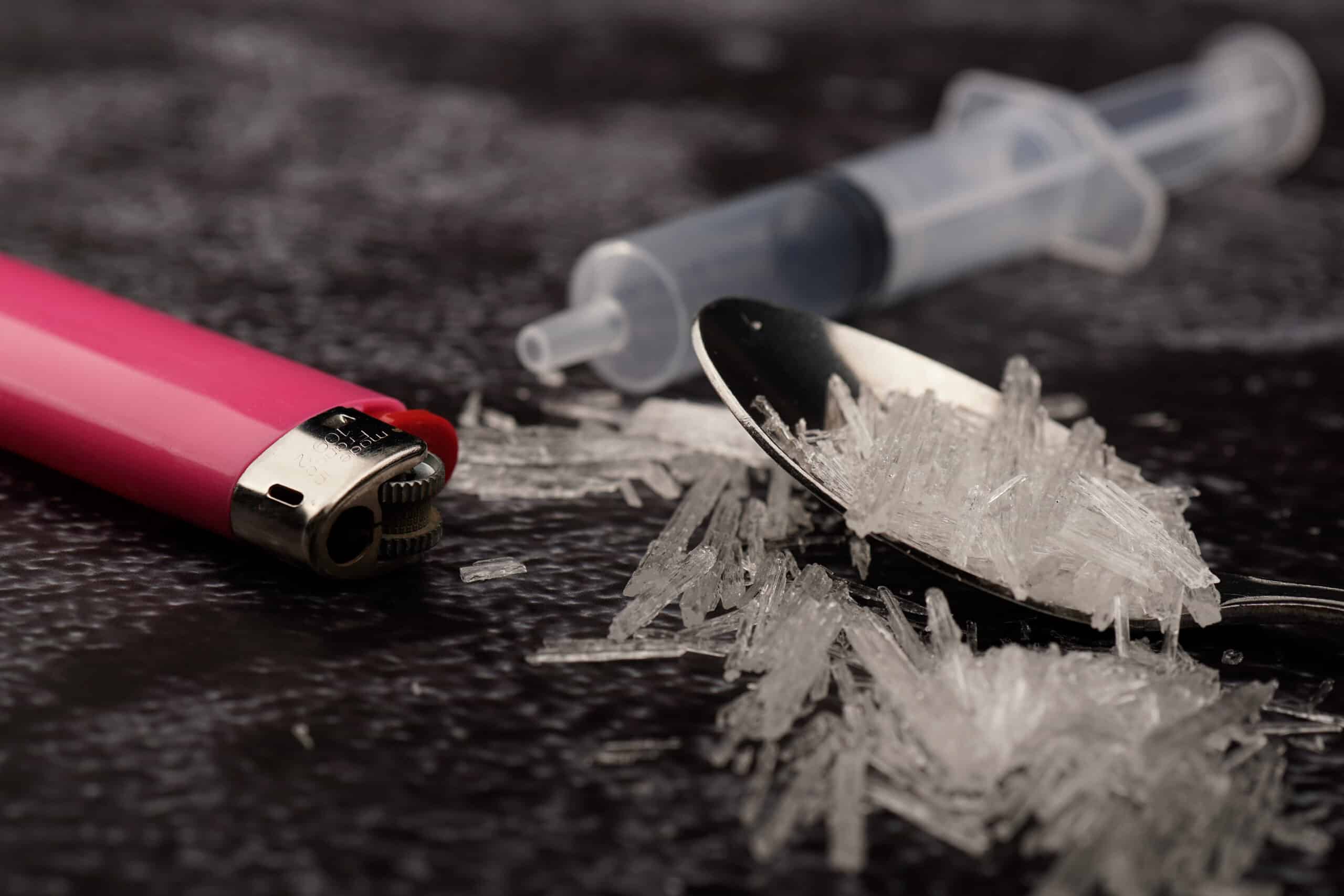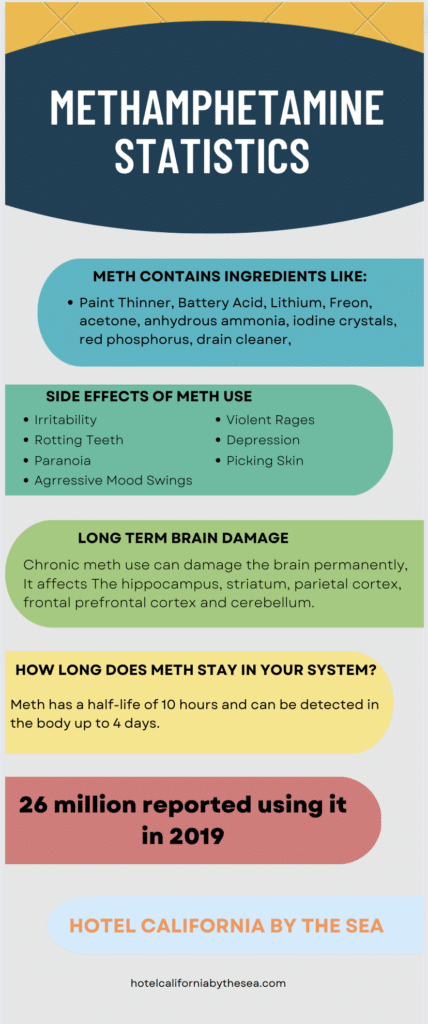How long does Meth stay in your system?
Methamphetamine (meth) is a powerful and highly addictive stimulant drug. In 2020, an estimated 2.6 million people reported using meth. An estimated 1.5 million people have a meth use disorder. An estimated 23,837 people died from an overdose that involved meth.
The DEA classified meth as a Schedule II Stimulant. This ranking means it is only legally available through a non-refillable prescription. The only legal form of meth is Desoxyn, a medication used to treat obesity and ADHD. Like other strong stimulants, meth can cause many harmful effects on the body and brain.
Meth is a stimulant drug that affects the central nervous system. It shares the closest chemical similarity with amphetamines, which doctors use to treat ADHD and some sleep disorders.
Meth works by increasing the amount of natural chemical dopamine in the brain. Dopamine controls many important body functions. These include movement, motivation and reinforcement and rewarding behaviors in the brain. The rapid release of dopamine helps to reinforce drug-seeking behaviors to feel and achieve a “high.”
Other names or street terms for meth include speed, glass, clear, chalk, ice, crystal and crank.

Signs of Meth Use
- Rapid movements
- Twitching
- Paranoia
- Dilated pupils
- Noticeable and sudden weight loss
- Skin sores
- Rapid eye movement
- Reduced appetite
- Agitation
- Burns on lips or fingers
- Rotting teeth
- Erratic sleeping patterns
- Outbursts and mood swings
- Repetitive behaviors
- Psychosis
Meth increases brain activity, causing rapid speech, reduced appetite, and intense pleasure. Individuals can take meth by smoking, swallowing, snorting, or injecting it. Smoking or injecting meth sends it quickly to the bloodstream and brain, causing an immediate rush of euphoria.
How long does Meth stay in your system?
Many people ask, “How long does meth stay in your system?” as it can vary based on usage and individual factors.
Meth is generally considered more dangerous because it remains in the body longer, even after the effects wear off. The drug can also be present in the brain for much longer. This often leads individuals to consume more meth in an attempt to experience the “high.” Users may double or triple their doses because the drug hasn’t fully left the body.
Because meth can take effect quickly, the “high” and pleasure feels can also begin to fade just as quickly. This causes people to take multiple doses in a “binge and crash” pattern of drug use. “Binge and crash” describes a period lasting anywhere from 3 to 15 days at the end of a drug binge.
After binging on meth excessively, a person can no longer achieve that desired feelings of intense pleasure and euphoria. The person will begin to develop symptoms of anxiety, paranoia, and insomnia. This can also be referred to as “tweaking”.
Afterward, in the crash phase, a person may experience meth withdrawal symptoms. These include long periods of sleep, intense drug cravings and feelings of depression.
The effects of meth can last anywhere from 8-24 hours. In those who struggle with meth use disorder, it can last up to 4 days in the body with a half-life of about 10 hours. On average, it takes the body 10 hours to remove half of the meth from the bloodstream. For regular users, the question of how long does meth stay in your system becomes more complicated as it may linger for longer periods.
The answer to “how long does meth stay in your system” varies widely. Testing methods play a big role in answering how long does meth stay in your system. Generally, saliva testing can detect meth use for up to 2 days. Urine testing can detect meth for approximately 3 days. A hair test can detect meth in the body up to 90 days after use.

What does Meth look like? What does Meth smell like?
So what does meth look like? Meth can come in many different forms. Regular meth is often a white powder, which can also be made into pills. Crystal meth resembles glass-like fragments that are shiny and look like white quartz.
What does meth smell like? Meth is typically odorless. But the smell can depend on the purity of the drug.
Some meth can smell like chemicals such as cleaning products. Sometimes, the chemical smell can have a sweet or bitter odor.
Side Effects and Symptoms of Meth Use
- Increased energy
- Decreased appetite and malnutrition
- Faster breathing
- Heart damage
- Increased blood pressure
- Increased body temperature
- High risk for blood-borne diseases such as HIV/AIDS
- Increased risk for developing Parkinson’s Disease – a disorder of the nerves that affect body movement
- Extreme weight loss
- Severe dental issues
- Intense itchy
- Anxiety
- Changes in brain structure and function
- Confusion and memory impairment
- Sleeping disorders
- Paranoia and hallucinations
- Violent behavior
- Stroke, heart attack and multiple organ failure
Check Your Insurance Coverage for FREE
Find out if your insurance covers addiction treatment in minutes. We accept most insurance!
Differences and Similarities between Meth and Cocaine
Meth and cocaine are both central nervous system stimulant drugs. They produce similar effects on the brain and body. Meth is made entirely synthetically, while cocaine is a plant-derived drug.
Meth stays in the brain for longer and can produce prolonged stimulant effects on the body. With meth use, 50% of the drug has been removed from the body within a period of 12 hours. With cocaine, 50% of the drug is removed from the body within 1 hour.
The ways in which both drugs work in the body are quite similar. Meth increases dopamine release and blocks the dopamine re-uptake in the brain. Cocaine simply blocks dopamine re-uptake in the brain. Both meth and cocaine are highly addictive and can lead to dependence and substance use disorder when misused.
How to Recognize a Meth House
Meth is a man-made synthetic drug created with the ingredients pseudoephedrine or ephedrine. These ingredients are found in over-the-counter cold and cough medicines. “Cooking” or creating meth can be extremely dangerous. The fumes from cooking meth are extremely toxic and can cause explosions and fires.
- Unusual and powerful odors, similar to ammonia or other chemicals, come from the property. Some have described smells similar to cat urine or rotten eggs.
- The windows of the house are covered or blacked out to prevent people from seeing inside.
- The house has strange forms of ventilation. Unusual ventilation practices are used to rid the house of toxic fumes produced by the meth-making process. Sometimes windows will be open on rainy days or at times when it seems wrong for the weather. The houses will also have an unusual amount of air fans and blowers.
- Elaborate security systems such as signs outside saying keep out and beware of dogs are also signs of a meth house. They may have an excessive number of video cameras installed.
- Dead vegetation outside the home indicate the dumping of toxic waste and substances onto the yard. Burn pits and dead spots of grass are clear indicators for chemical dumping.
- Excessive or unusual trash on the property can be a sign of meth-making. Meth makers produce large amounts of trash when creating meth. These can include: cold tablet packaging, lithium batteries, empty containers, plastic bottles, rubber hoses, duct tape, and gloves.
- Unusual behavior of the occupants. This can include paranoia, staying inside most of the time, smoking outside the house, and frequent visitors.
Reach out to Hotel California by the Sea
We specialize in treating addiction and other co-occurring disorders, such as PTSD. Our Admissions specialists are available to walk you through the best options for treating your addiction.
The symptoms of meth abuse can last for months or even up to years after a person has quit using the substance. Meth is dangerous because it destroys the brain’s pleasure center. This makes it much more difficult for the brain to naturally achieve any sort of feeling of pleasure without the assistance of the drug.
Our meth use disorder treatment program specializes in treating people who struggle with this highly dangerous substance. Programs including detox, residential, PHP and IOP provide support, education and evidence-based treatments to all clients.
Treatments such as CBT, group therapy and EMDR therapy help clients better understand the root causes of their addiction. In treatment, clients receive intensive one on one counseling as well as participate in group therapy sessions. Hotel California by the Sea provides the tools and resources for successful recovery.
References:
https://nida.nih.gov/publications/research-reports/methamphetamine/overview
https://www.medicalnewstoday.com/articles/how-long-does-meth-stay-in-your-system
https://www.dea.gov/sites/default/files/2020-06/Methamphetamine-2020_0.pdf
